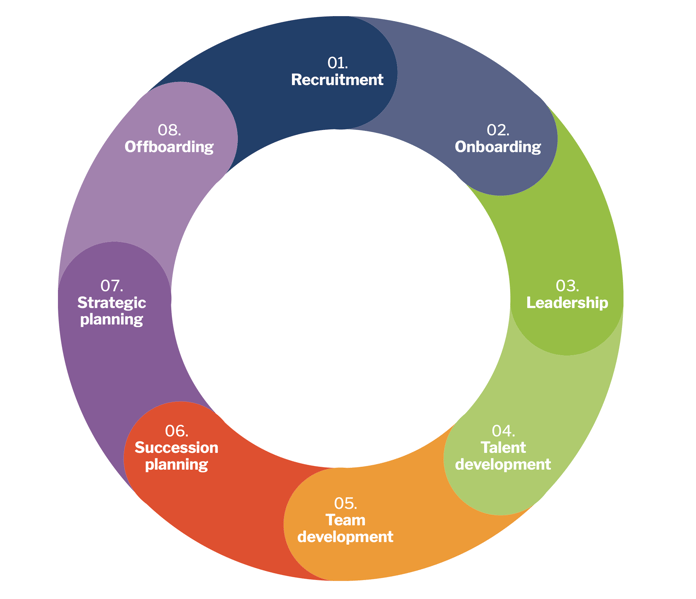
Strategic planning
9.1 Understanding organizational needs through data
Why is success truly a success?
In every C-level decision, it's essential that choices are made based on solid, informed insights. Just as you wouldn’t make large investments without thorough due diligence, organizations use BI and other systems to track and understand business progress. Yet, a company is nothing without its people. Employees' motivation, engagement, and alignment with the company’s goals are crucial to achieving success.
There are several critical challenges at the C-level that can only be effectively addressed through a deep understanding of organizational needs using people data. These challenges include:
- Ensuring stronger performance aligned with business strategy and goals: How do we make sure our workforce is driving the company forward in line with its strategic objectives?
- Transforming teams into high-performance units: How can we create significant performance improvements and turn regular teams into high-performance teams?
- Increasing customer focus across the organization: Employees need to understand and communicate with customers without personal biases clouding interactions.
- Improving top-down communication: How can C-level executives communicate more effectively with employees in a way that ensures everyone understands leadership's vision and strategies, leading to better execution across the company?
- Optimizing talent management and promotion decisions: How do we ensure that promotions are based on objective data and insights, so that the right people are promoted for the right reasons?
By leveraging data to understand your organization’s unique needs, you can not only address these challenges but also unlock the full potential of your workforce.
The solution we recommend for understanding organizational needs through data is The Predictive Index, which supports the entire employee life cycle across 8 phases. By continuously working with objective data in all 8 phases, you bring your organization closer to achieving the success you're aiming for.

Top 4 benefits of focusing on the 8 phases:
- A more motivated organization: By continuously addressing employee needs through each phase, motivation and engagement improve across the board.
- Clearer picture of gaps and potential: Gain insight into where your organization excels and where it can improve, ensuring that resources are directed where they are needed most.
- Better alignment between business goals and talent strategy: Ensure that your talent strategy directly supports your business objectives, driving success on both fronts.
- A stronger foundation for future growth: Build a solid base that enables your company to evolve more easily and sustainably over time.
Want to see cases and learn how other C-level leaders have improved performance and boosted sales and profits by gaining better control of their people data?

Contact Michael Kirk Jensen!
9.2 Aligning your organization with strategic goals for sustained success
Organizational misalignment limits growth potential
Many organizations face challenges in aligning their collective workforce with their long-term strategic objectives. Without a clear understanding of how the organization’s capabilities match the company’s goals, you risk:
- Inefficiencies across departments: Different parts of the organization may be working toward different goals, leading to fragmentation and wasted effort.
- Difficulty executing strategy: Without alignment, strategic initiatives often struggle to gain traction and fall short of expected outcomes.
- Underutilized resources: Valuable talent across the organization may not be fully leveraged due to misalignment with strategic priorities.
Align your entire organization with strategic objectives
PI’s powerful tools allow you to take a holistic view of your organization, identifying where your strengths and capabilities lie in relation to your strategic goals. By mapping out the entire organization with PI’s insights, you can see how various teams and departments contribute to the company’s overall objectives.
This broader perspective helps leaders ensure that their entire workforce is working toward common goals, while also identifying areas where realignment is necessary. PI’s data-driven approach ensures that your talent infrastructure is optimized for future growth, making sure that you have the right people in the right roles to drive success.
Top benefits of working with data for organizational alignment:
- Clear organizational alignment: Ensure that every part of the organization is contributing to strategic goals, reducing inefficiencies.
- More effective execution of strategy: Aligning the entire organization around shared objectives makes it easier to implement strategic initiatives successfully.
- Optimized use of resources: By understanding how each department fits into the bigger picture, you can better leverage the full potential of your workforce
-
Want to ensure your organization is fully aligned and prepared to achieve your strategic goals?
Contact us to learn how PI can help you take a data-driven approach to organizational success.

Contact Michael Kirk Jensen!